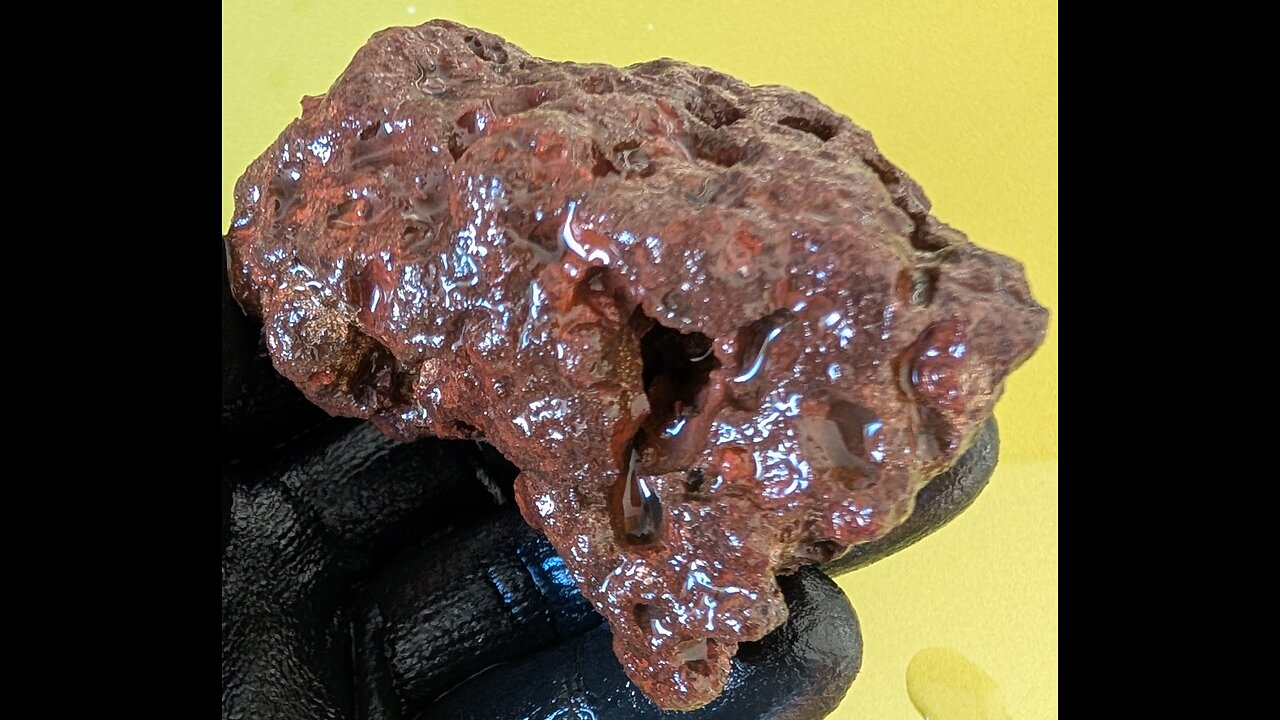Premium Only Content

Lava chunk!
Lava rock, often referred to simply as "lava," is a term commonly used to describe various types of igneous rocks that form from the cooling and solidification of molten lava on the Earth's surface. Here are some key details about lava rock:
Formation: Lava rock forms when magma, which is molten rock beneath the Earth's surface, erupts as lava during a volcanic eruption. Once exposed to the cooler temperatures at the surface, the lava cools and solidifies into rock.
Types of Lava Rock:
Basalt: The most common type of lava rock, formed from low-viscosity, mafic lava. It's dark, fine-grained, and can have a vesicular (full of small holes) texture if gas escapes during cooling.
Andesite: Intermediate in composition, often found in subduction zones. It's lighter in color than basalt and can have a porphyritic texture.
Rhyolite: Formed from high-viscosity, felsic lava, typically light in color with a fine-grained or glassy texture. It often forms during explosive eruptions.
Pumice: A very light, porous form of lava rock with a high gas content, which can float on water due to its low density.
Obsidian: A volcanic glass that forms when lava cools very rapidly, preventing crystal growth. It's usually black but can have other colors due to impurities.
Texture: The texture of lava rock varies widely:
Aphanitic: Fine-grained, where individual crystals are not visible to the naked eye due to rapid cooling.
Vesicular: Contains gas bubbles or vesicles, common in basalts and pumice.
Glassy: Like obsidian, where the rapid cooling prevents crystal formation.
Porphyritic: Contains larger crystals (phenocrysts) within a finer matrix, indicating a two-stage cooling process.
Color: The color can range from black or dark gray (basalt, obsidian) to light gray, pink, or even white (rhyolite, pumice), depending on the composition and cooling rate.
Uses:
Landscaping: Lava rock is often used in gardens for its aesthetic appeal and drainage properties.
Construction: Crushed lava rock can be used as aggregate in concrete or as a building material.
Art and Jewelry: Some types, like obsidian, are used in crafting jewelry or decorative items.
Abrasives: Pumice, due to its abrasive nature, is used in various cleaning and polishing applications.
Geological Significance: Lava rocks provide evidence of volcanic activity, helping geologists understand volcanic processes, the composition of the Earth's mantle, and the history of volcanic eruptions in a region. They are also studied for their role in soil formation and ecosystem development after volcanic events.
-
 59:43
59:43
Sarah Westall
6 hours agoVietnam Shuts down 86 Million Bank Accounts, The Fourth Turning & more w/ Andy Schectman
56.7K11 -
 1:17:51
1:17:51
Flyover Conservatives
13 hours agoMary Flynn O’Neill and Clay Clark: The Church Must Rise or America Falls | FOC Show
50K12 -
 3:36:01
3:36:01
I_Came_With_Fire_Podcast
16 hours agoThe Global ANTIFA Connection You've Never Heard Of | The Israel Question
43.3K11 -
 16:38
16:38
RTT: Guns & Gear
23 hours ago $5.59 earnedExtar EP9 Review: The Best Budget 9mm PCC?
57.3K6 -
 7:53
7:53
Rethinking the Dollar
16 hours agoMass Firings in Tech: The Real Agenda Behind 166,000 Cuts
61.1K16 -
 1:02:28
1:02:28
BonginoReport
10 hours agoFeds Monitor Threats Ahead of Kirk Memorial - Nightly Scroll w/ Hayley Caronia (Ep.138)
267K153 -
 55:51
55:51
Candace Show Podcast
9 hours agoWho Moved The Camera Right Above Charlie's Head? | Candace Ep 239
123K664 -
 13:09:13
13:09:13
LFA TV
1 day agoBREAKING NEWS ON LFA TV! | FRIDAY 9/19/25
266K56 -
 13:00:46
13:00:46
Total Horse Channel
19 hours ago2025 WDAA Western Dressage World Championship Show | Day Four | Arena One
26.1K -
 2:08:52
2:08:52
The Mike Schwartz Show
12 hours agoTHE MIKE SCHWARTZ SHOW Evening Edition 09-19-2025
46.5K4